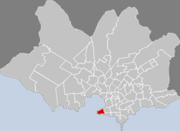Ciudad Vieja, Montevideo
Ciudad Vieja | |
|---|---|
Historic City Centre | |
Views of the Old City | |
 Street map of Ciudad Vieja | |
 Location of Ciudad Vieja in Montevideo | |
| Coordinates: 34°54′24″S 56°12′30″W / 34.90667°S 56.20833°W | |
| Country | |
| Department | Montevideo Department |
| City | Montevideo |
Ciudad Vieja (Spanish pronunciation: [θjuˈðað ˈβjexa], Old City) is a barrio (neighbourhood or district) of Montevideo, Uruguay. Located in a peninsula at the mouth of the Bay of Montevideo, it is the city's historic district. It was founded in 1724 as a walled city by the Spanish Empire. Following Uruguay’s independence, it became a district of the expanding city, which quickly grew beyond the original fortress, later dismantled.[1]
As one of the city's central districts, it forms part of its central business district alongside Centro and Cordón. It serves as a key office district, hosting several commercial banks and other financial institutions, government buildings, as well as museums, cultural venues, theaters and art galleries.[2] The district also features a high concentration of Art Deco, Art Nouveau, and Neoclassical buildings.[3]
History
[edit]Until 1829 it was surrounded by a wall that protected it from possible invasions. After the wall was torn down, the only part of it that was preserved was the main gateway to the Citadel, which remains to this day as an emblem of Montevideo. Some street names recall the presence of the wall, like Ciudadela (citadel) or Brecha (breach), which owns its name to the breach in the wall that the British managed to open to enter the city during the 1807 British invasion and brief occupation of the city before they were defeated.
Present
[edit]The main street, Sarandí, was turned into a pedestrian walkway in 1992, which increased its commercial and tourist attractiveness. In 2005 it was extended beyond the Constitution Square.
Ciudad Vieja has elegant buildings from the colonial era and the first decades of independence. The Cabildo (built between 1804 and 1812), the Solís Theatre, the Metropolitan Cathedral, and several museums, like the Museo Torres García[4] are among the most impressive ones. Also, several design shops and recycled loft floors flourish in the streets near the port.
Important buildings
[edit]- Bolsa de Valores de Montevideo
- Cabildo de Montevideo
- Mercado del Puerto
- Palacio Taranco
- Central Bank of Uruguay
- Solís Theatre
- Cathedral of the Immaculate Conception, St. Philip and St. James (head of the Roman Catholic Church in Uruguay)
- Parish Church of St. Francis of Assisi (Roman Catholic)
- Church of Our Lady of Lourdes and St. Vincent Pallotti (Roman Catholic, Pallottines)
- Cathedral of The Most Holy Trinity, popularly known as the English Temple (Anglican)
- Sephardic Jewish Community (Synagogue)[5]
Gallery
[edit]-
The Gateway of Ciudadela, was the entrance to the fortress of Montevideo
-
Street in the Ciudad Vieja
See also
[edit]References
[edit]- ^ "Ciudad Vieja | Municipio B". municipiob.montevideo.gub.uy. Archived from the original on 2024-12-13. Retrieved 2025-02-10.
- ^ "La Ciudad Vieja: hermoso testimonio del pasado". EL PAIS. 2004-07-05. Retrieved 2025-02-10.
- ^ "La capital del estilo Art Decó". EL PAIS. 2020-08-21. Retrieved 2025-02-10.
- ^ Torres Garcia Museum
- ^ Jewish Tourism in Uruguay - Temples
Bibliography
[edit]- Assunção, Fernando O.; Bombet Franco, Iris (1991). Ciudad Vieja. Cuadernos del Boston (in Spanish). Vol. 1. Montevideo.
{{cite book}}: CS1 maint: location missing publisher (link)












